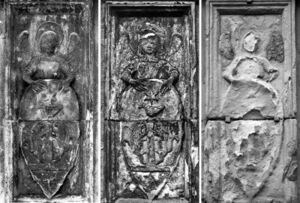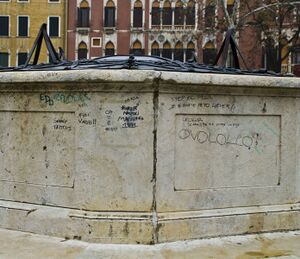Damage to public art

Public art, because its ownership is ambiguous and it is usually exposed to the elements, endures daily threats from a variety of different sources.
Natural Damage

The Venetian climate is a hostile environment; art is exposed to salt spray, direct sunlight, high humidity, and erosive factors. Venice experiences freezing temperatures in wintertime. Liquid water that has entered porous stone can freeze then crystallize and expand, often producing a cascading effect of cracks throughout the stone[1]. In other seasons, high humidity and the warmth of the sun combine to cyclically hydrate and dehydrate the stone on a daily basis, increasing the stresses upon it and, consequently, its rate of erosion. Bacteria, algae, and other organisms that thrive in damp environments have also made homes on many pieces of outdoor sculpture, and their byproducts are typically corrosive in nature.
Human Damage

For centuries, Venetian households and vaporetti burned dirty wood, coal and oil, causing black grime to accumulate on white marble surfaces; much of it is still present today. Although Venice now burns exclusively natural gas and boat engines are held to increasingly strict emissions standards, mainland industrialization has had a negative effect on Venetian public art. Venice is fortunate enough to enjoy prevailing onshore winds, but it is not immune to acid rain and fog, both of which cause the deterioration of marble and other similar materials. As erosion occurs, the outer surfaces of sculptures are chemically altered, eventually detaching and falling off completely.
The greatest source of damage to public art is human-related. Neglect, theft, disregard, and vandalism have all had significant roles in the accelerated deterioration of many objects in the Venetian public art collection. In the past twenty years, 49 pieces of the original documented collection of public art in Venice have disappeared. Routinely, objects are removed behind scaffolding during renovations, only to never be replaced afterwards.
People sit on public wells and kick their feet against them, spray graffiti on sculptures, touch statues, all without consideration of the fact that many pieces of outdoor sculpture in Venice are as important, historically and artistically, as objects found in museums or art galleries. Venetian utilities have strung up wires, cables, and drainage pipes in front of public art pieces, sometimes attaching infrastructure directly to the sculptures. One hundred and eighty pieces are affected by this particular problem[2].
See Also
References
Bibliography
NULL